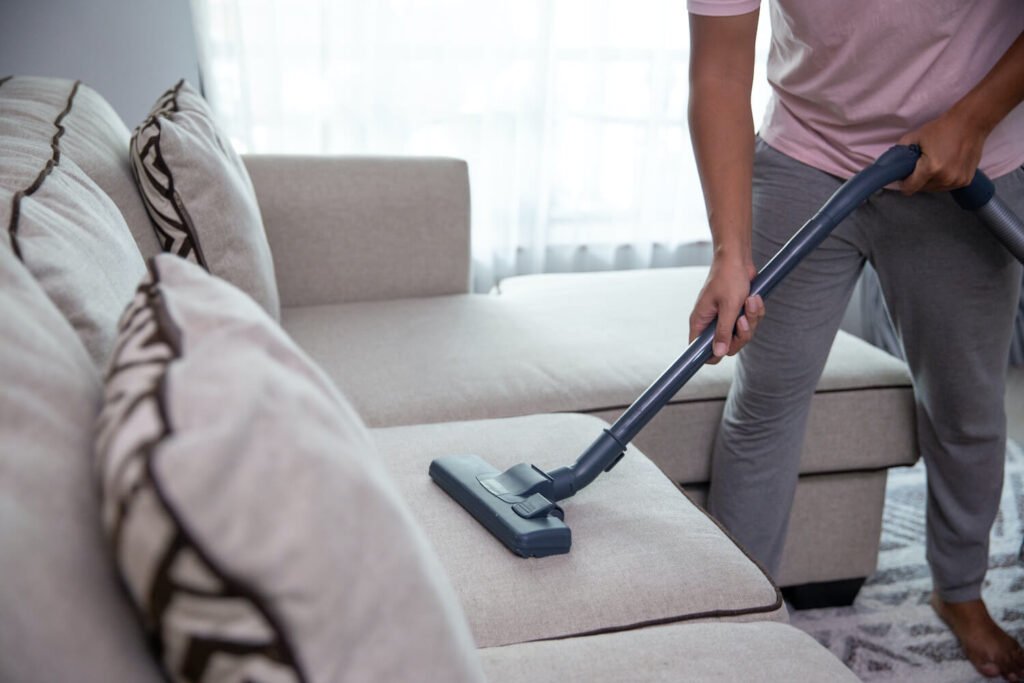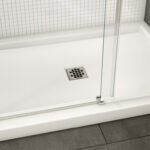Last updated on June 26th, 2023 at 12:54 am
Do your couch cushions appear worn and stained? It is possible to revitalize them and give your living room a new appearance. In this guide, we will demonstrate how to effectively clean sofa cushions so that they are free of grime, dust, and unsightly stains.
By carefully following our step-by-step instructions, you can easily restore the comfort and attractiveness of your cushions. We will discuss removing the cushions, vacuuming, spot-cleaning discoloration, and deodorizing.
With our tips and techniques, you will be able to transform your sofa cushions and create a warm and inviting environment for you and your family. Prepare to experience spotless and revitalized sofa cushions!
Why is it Important to Clean Sofa Cushions?
Regularly cleaning your sofa upholstery is essential due to the numerous benefits it provides. Consider the following arguments for maintaining their cleanliness:
Improved Hygiene: Over time, sofa cushions collect dust mites, pathogens, and allergens that can negatively impact indoor air quality and contribute to respiratory problems.
Regular cleansing ensures a clean and sanitary environment for you and your family, thereby reducing the risk of allergies and promoting overall health.
Stains, dirt, and grime can diminish the aesthetic allure of your sofa cushions, making them appear drab and unwelcoming. By regularly cleaning the cushions, you can effectively eradicate these unsightly elements and restore their pristine appearance.
This revitalization improves the overall appearance of your settee, creating a fresh and inviting atmosphere in your living room.
Extended Lifespan: Regular upkeep and cleansing contribute significantly to the durability of your sofa cushions. Removing accumulated dirt, stains, and debris helps maintain the fabric’s integrity by preventing irreparable damage or fiber deterioration.
By actively maintaining sanitation, you can protect your investment and extend the life of your sofa’s comfort.
By understanding the significance of cleaning your sofa cushions, you can maintain a hygienic environment, improve the aesthetic appeal of your furniture, and extend its lifespan, thereby assuring years of comfort and satisfaction.
Materials Needed for Cleaning Sofa Cushions

Photo Credit: mydomaine
When it comes to cleaning sofa cushions, having the proper equipment can make the task much simpler and guarantee effective results. Before beginning, collect the following materials:
For removing loose grime, dust, and debris from the cushions, a vacuum cleaner with an upholstery attachment is required.
Brush with soft bristles: A brush with soft bristles can be used to scrub the cushions carefully and remove any embedded dirt or stains.
Choose a mild detergent that is appropriate for the fabric of your couch cushions. Avoid using harsh compounds that could cause damage or discoloration.
Tepid water: For cleaning the cushions, you will need tepid water to combine with the detergent. Ensure that the water is not too heated to prevent the fabric from shrinking or being damaged.
These will be utilized for applying the detergent solution and removing discoloration. Ensure that the fabrics are free of any dyes or patterns that may migrate onto the cushions.
A pail or basin will be useful for combining the detergent and warm water. If you prefer to spray the detergent solution on the cushions as opposed to soaking them, a spray container can be useful.
After cleansing, you’ll want to dry the cushions thoroughly with a fan or air dryer to prevent mold and mildew. A fan or air dryer can assist in accelerating the drying process.
Cleaning Sofa Cushions
Before beginning the cleaning procedure, examine the care label on the sofa cushions for specific instructions. Different fabrics may necessitate distinct cleansing procedures.
If your cushion coverings are detachable, remove them from the cushions by unzipping or unfastening them. This will enable you to sanitize them individually.
Use a vacuum with a brush attachment to remove loose dirt, dust, and detritus from the cushions. Pay close attention to cracks and joints.
If there are any stains on the upholstery, they should be treated immediately. Utilize a mild detergent diluted in water or a cleanser designed specifically for cleaning upholstery. Using a clean cloth, delicately blot the stain from the outside in.
Follow the cleaning instructions on the care label to properly clean the cushion coverings. The majority of covers are machine- or hand-washable in cool water. Use a gentle detergent and allow them to air dry to prevent shrinkage.
Deodorize and refresh: Sprinkle baking soda over the cushions and let it remain for a few hours to eliminate odors. Remove the baking soda by thoroughly vacuuming the upholstery.
If the cushions themselves became damp during cleaning, allow them to dry completely before replacing the covers. Reassemble the cushions: Once everything is dry, zip or otherwise secure the cushion coverings to the cushions.
Prepare the Cushions
Begin by carefully detaching the sofa cushions from the frame to ensure their safe removal. Find solace on a spotless, level surface, such as a table or the floor, where each cushion is accessible without obstruction.
This strategic maneuver will facilitate an enhanced cleaning experience, allowing you to attend to and clean each cushion with the uttermost care.
Vacuum the seat cushions

Photo Credit: thehardwarehub
Utilizing a vacuum cleaner equipped with the appropriate upholstery attachment, suction the cushion surfaces gently to remove any loose dirt, dust, and detritus.
Pay special attention to the crevices and nooks, as these are ideal locations for the accumulation of undesirable particles over time.
Ensure a thorough removal of all extraneous elements, leaving your upholstery revitalized and devoid of any lingering impurities.
Spot Test
Prior to cleaning the entire cushion, it is of the utmost significance to perform a spot test on a small, inconspicuous area.
This preliminary examination will effectively determine the cleaning solution’s compatibility with the fabric, thereby preventing discoloration or damage.
Adhere assiduously to the cleaner or stain remover’s label instructions, scrupulously following the prescribed steps for the spot test.
By engaging in this prudent practice, you will ascertain the safety and suitability of the cleaning solution for your cherished cushion, thereby assuring a thorough and successful cleaning.
Remove Stains
If there are stains on the cushion, it is time to eliminate them. Here are some techniques for eliminating common stains:
For stains caused by food and beverages, combine a small volume of mild detergent with distilled water. Apply the solution to a clean cloth and delicately blot the stain. Apply to blot until the stain is removed.
Sprinkle baking soda or cornstarch over oil stains to remove them. Allow it to remain for a few minutes so that the grease can be absorbed. Utilize a soft brush or sponge to scrub the stain gingerly. Vacuum up the residue and, if necessary, repeat.
Apply rubbing alcohol to clean the fabric and dab the stain to remove ink stains. Be cautious not to rub vigorously, as this may cause the ink to disseminate. Continue to dab until the stain is eliminated.
Consider using a cleaner or stain remover designed specifically for the fabric of your sofa cushions to eliminate intractable stains. Follow the product’s instructions attentively.
Cleanse the Fabric
To clean the cushion’s entire fabric, combine a small volume of mild detergent with distilled water in a bucket. Using a soft-bristled brush or sponge dipped in the cleaning solution, scour the cushion gently in a circular motion. Avoid vigorous scouring, as it may cause fabric damage.
After cleansing, thoroughly rinse the cushion with clean water to eliminate detergent residue. You can use a water-filled spray container for this purpose. Alternatively, you can remove the detergent with a clean cloth moistened in water.
Drying the Cushions

Photo Credit: beezzly
Prioritize the thorough drying of the cushions before reinstalling them on your cherished sofa once the cleaning process has been completed successfully. Here are some helpful hints for accelerating the drying process:
Find a well-ventilated area with excellent air circulation to ensure the ideal drying conditions. However, it is recommended to avoid direct sunlight, as its powerful rays may cause the fabric to fade or diminish.
To promote uniform drying on both surfaces, flip the cushions periodically during the drying period, ensuring uniform moisture evaporation.
If time is of the essence, a fan can be utilized to accelerate the drying process. However, exercise caution by maintaining a safe distance between the cushions and the fan to prevent direct airflow, as this could result in unintended fabric stretching or distorting.
By adhering to these helpful tips, you will be able to successfully dry your cherished cushions and prepare them for their rightful place on your sofa with the utmost efficiency and care.
With the cushions now fully dried, it is time to restore
Start by fluffing the cushions using delicate motions to restore their original shape. Proceed by kneading and massaging the cushions with a light touch to distribute the filling evenly throughout.
Once the cushions have been revitalized, they should be reinstalled onto the sofa’s frame. Ensure a firm and secure fit, allowing the cushions to occupy their proper position.
By adhering to these steps, you will be able to successfully refresh your sofa with plush, comfortable cushions that are ready to embrace moments of relaxation and tranquility.
Preventing Future Stains and Dirt
Now that your sofa cushions are clean and odor-free, it is essential to take preventative measures to ensure that they remain so. Here are some strategies for preventing future stains and soiling:
Regular upkeep: Vacuum your sofa cushions routinely to remove dust and debris from the surface. This will prevent their thorough penetration into the fabric.
No Eating or Drinking: To reduce the risk of spillage and stains, avoid eating and drinking on the sofa.
Cover the Cushions: Cover your sofa’s cushions with protective coverings or throws. These are readily removable and washable, adding an extra layer of protection against stains and dirt.
Immediately Remove Stains: If an accident occurs, remove it immediately. Absorb the liquid with a clean cloth or paper towel to prevent it from penetrating the fabric.
Follow Manufacturer’s Care Instructions: Always refer to the sofa manufacturer’s care instructions. To avoid damaging the cushions, it is essential to adhere to the cleaning instructions for each fabric type.
By adhering to these precautions, you can preserve the purity and durability of your sofa cushions for many years.
FAQs Concerning the Care of Sofa Cushions
Can Sofa Cushions Be Washed In A Machine?
It depends on the sofa cushion fabric. Some varieties of fabric are machine-washable, whereas others require hand-washing or professional cleaning.
Consult the manufacturer’s instructions or a professional cleaner to ascertain the proper method for cleaning your cushions.
How Often Should Sofa Upholstery Be Cleaned?
The frequency of cleansing is contingent on usage, environment, and the presence of stains. As a general rule, you should clean your settee cushions every six to twelve months for routine maintenance. If accidents or stains do occur, it is best to address them immediately.
What Natural Remedies Are Available For Eradicating Stains From Sofa Cushions?
Sofa cushion stains can be effectively removed using natural remedies. A mixture of vinegar and water, for instance, can eliminate odors and light discoloration.
Lemon juice can remove ink stains, while baking soda can absorb oil stains. Before administering any natural remedy, always conduct a spot test to ensure compatibility with the fabric.
Can bleach be used to sanitize sofa cushions?
Bleach is not recommended for use on sofa cushions unless the fabric specifically permits it. Bleach can discolor and deteriorate certain varieties of fabric. Choose fabric-safe mild detergents and non-bleach stain removers as an alternative.
How long does it take for cleaned sofa cushions to dry?
Depending on variables like fabric thickness, humidity, and air circulation, the drying time for sofa cushions can vary. It can take anywhere from six to twelve hours for sofa cushions to dry completely, on average.
To expedite the drying process, you can increase air circulation in the room with blowers or open windows.
Can I employ a professional to sanitize my sofa cushions?
Yes, hiring a professional sofa cushion cleaner is a viable option, particularly if you’re dealing with stubborn stains or delicate fabrics.
Professional cleaners have the knowledge and specialized equipment to effectively clean and restore sofa upholstery.
It is advisable to conduct research and select a reputable upholstery cleaning service with a solid reputation.
Bottom Line
Cleaning your sofa cushions is essential to sustaining a clean and comfortable living environment. By following this article’s step-by-step instructions, you can effectively eradicate stains, refresh the fabric, and extend the life of your sofa cushions.
Remember to use the proper cleaning methods and materials based on the type of fabric, and always conduct area tests prior to applying cleaning solutions.
With routine upkeep and preventative measures, your sofa cushions will remain clean, fresh, and inviting for many years.
















